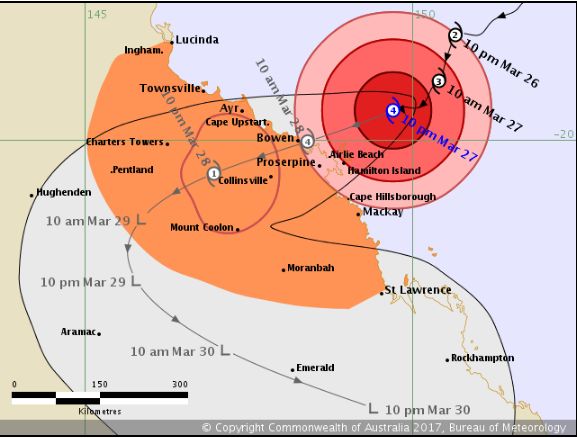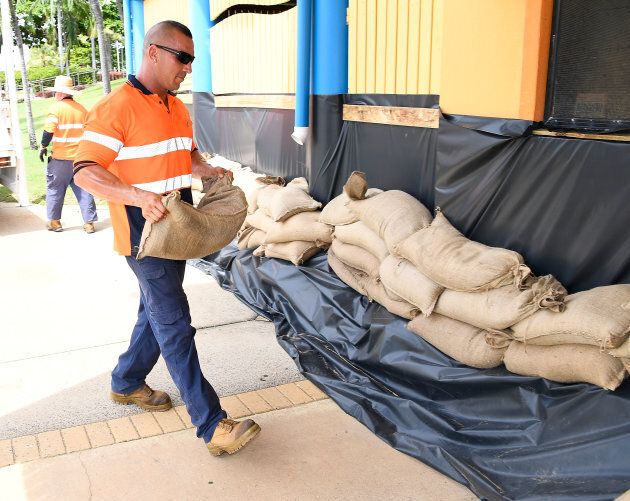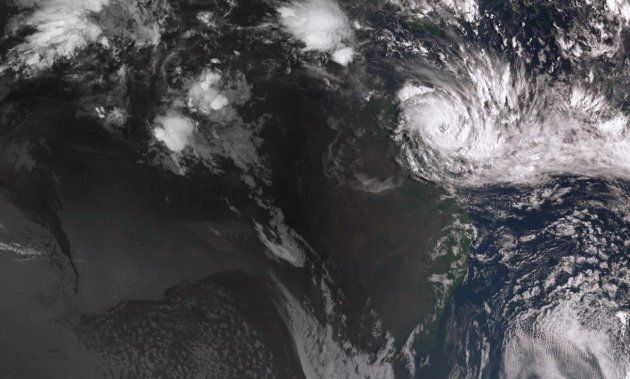Tropical Cyclone Debbie has been upgraded to a Category 4 storm overnight, as Queensland residents experience strong winds, rain and power outages.
The Bureau of Meteorology reported on Tuesday morning that the destructive core of the cyclone was striking the Whitsunday Islands, and was on track to cross the mainland between Ayr and Midge Point, north of Mackay, around midday.
Wind speeds of up to 260kmh are expected at the eye of the storm, but destructive winds will be experienced in a wider area.
"Destructive winds with gusts over 125 km/h... may extend further north along the coast to Townsville and to adjacent inland areas, including Collinsville and Charters Towers, and Mount Coolon during the day," the BOM advisory read.
Residents of low-lying areas of Mackay were on Monday urged to leave immediately, Queensland Police Commissioner Ian Stewart said.
"We've moved whole towns before but nothing of this magnitude," the Commissioner said.
"Don't wait until tomorrow (Tuesday) because you will not be able to move."
Up to 25,000 people in the city of 85,000 live in areas which are expected to experience inundation of between 0.8 and 2.5m above the usual high tide mark.
Mackay Council has also released several maps of the areas that are expected to be most affected depending on varying storm surge levels, for residents who are yet to have evacuated. You can see them here.
"Because of the intensity and the timing we are very concerned about the prospective tidal surge in Mackay. Evacuations are underway at the moment in Mackay. It's very clear that the time to move is now. This is a severe weather system," Queensland Premier Annastacia Palaszczuk said.
WHAT IS STORM SURGE?
- We all think of the destructive winds as the number one cyclone-related danger, but storm surge is often more lethal to both property and life.
- Put simply, it's water that is pushed onshore by a cyclone's incredibly strong winds.
- A storm surge doesn't come in one big wave or "wall of water" like a tsunami, but as a sustained rise in sea level.
- When combined with high tide it is particularly dangerous. Not only does it cause flooding, but the force of the water blown onshore can be strong enough to cause major damage.
- High tide in the area expected to be struck by Cyclone Debbie is around 9am on Tuesday. If the cyclone makes landfall within an hour or so of that time, the effects of storm surge are likely to be severe.
- As an extreme example, the vast majority of the 1883 deaths in Hurricane Katrina in the U.S. were caused by storm surge.
- There's more information about storm surges on this page at the Bureau of Meteorology website.
At 1.30am Tuesday (EST) the cyclone was 180 kilometres north northeast of Mackay and 155 kilometres east northeast of Bowen, and moving west at 9kmh.
CYCLONE DEBBIE FACTS
- Expected to make landfall 12pm Tuesday between Ayr and Cape Midge Point; very destructive winds already affecting areas around the Whitsundays
- Wind gusts of up to 250 km/hr predicted
- Very destructive core us 100km wide
- Up to 300,000 Queenslanders affected
- Severe storm surges up to 4 metres anticipated
- Evacuation centres are open in Bowen and Proserpine for people who have no other option
- Pets are not allowed at Whitsunday shelters, with residents told to lock their pets inside their homes or find alternative accommodation
- Locals are being told to: evacuate if directed; charge your mobile phones; secure homes, boats and pets; stock up on essentials such as fuel and food; do not leave home or drive anywhere once gale force winds begin
Meanwhile Prime Minister Malcolm Turnbull has pleaded with Queenslanders to follow evacuation orders.
"For those in the path of Cyclone Debbie, please take care and stay safe," he told reporters in Canberra on Monday.
"If you have received an official evacuation order, you and your family must leave immediately."
Emergency services are warning residents to prepare early and not to travel on the roads once the wild weather starts, with one weather-related fatality already report -- a tourist who died in a car crash in Proserpine believed to be caused by wild weather.
Australian Defence Force personnel are being deployed to the region in anticipation of the storm's arrival.
Locals are being urged to stock up on essential supplies such as fuel before the gale-force winds begin, and to charge their phones as power outages are expected later in the day.
"People need to plan their day so that they are safe with family and friends as early as possible," Townsville Mayor Jenny Hill said.

The Whitsundays Regional Council has ordered evacuations for several areas, with a "significant storm tide" expected to flood low-lying areas.
Chair of the Whitsunday Disaster Management Group and Whitsunday Regional Council, Mayor Andrew Willcox, urged residents to seek shelter with family and friends wherever possible.
"If you are unable to evacuate, the Cyclone Shelters in Bowen and Proserpine will be opened on Monday as a last resort," he said today. "The cyclone shelters have capacity for 800 people each and are only available to those people at highest risk from cyclone effects that have no other option."

Schools between Ayr and Proserpine closed on Monday morning, and Palaszczuk said further school closures were likely.
#Townsville ATM is the definition of "the calm before the storm"... no cars no sound. Just a soft ominous breeze. #CycloneDebbiepic.twitter.com/dTbkYG6RJE
— LordDM (@Zacenjoysthewor) March 26, 2017
Cyclone Yasi was a Category Five storm when it hit Mission Beach on February 3 2011, destroying homes and causing $3.5 billion worth of damage along Queensland's coastline.
Although Cyclone Debbie is not predicted to reach that level of intensity, widespread destruction from the gale-force winds, storm surges and flooding is still likely.
